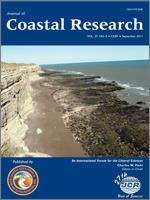South Lake Worth (Boynton) Inlet on the Southeast Florida Atlantic Coast. This inlet was originally dredged to provide better water circulation in Lake Worth but is now commonly used as a navigational entrance. Water flowing out of Lake Worth in the ebb tide is clearly visible as an oceanic plume in the center foreground as it contains tannic acids that make it darker colored than seawater. Note the curved jetty on the north (updrift) side of the inlet and deflection of suspended sediments in the littoral transport offshore (lighter toned area). The downdrift shore has retreated landward due to littoral drift blocking by the jettied inlet, which causes shore erosion. (Photograph by Charlie Finkl, Department of Geosciences, Florida Atlantic University, Boca Raton, FL 33431, USA).

South Lake Worth (Boynton) Inlet on the Southeast Florida Atlantic Coast. This close-up shot shows dark colored tannic acid-rich water flowing out of the Lake Worth lagoon into the Atlantic Ocean. The sand bypassing plant on the shoreward part of the curved north (updrift) jetty pumps sand that accumulates in a fillet as it is impounded by the jetty, which is a littoral drift blocker. Sand is pumped through a pipeline along the north seawall, under the bridge, and then ejected on the eroding downdrift beach. The outlet pipe is visible on the beach across from the road to the parking lot (lower left hand corner). (Photograph by Charlie Finkl, Department of Geosciences, Florida Atlantic University, Boca Raton, FL 33431, USA).






